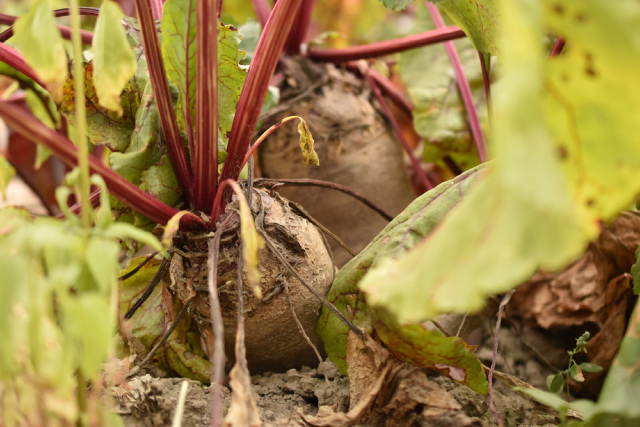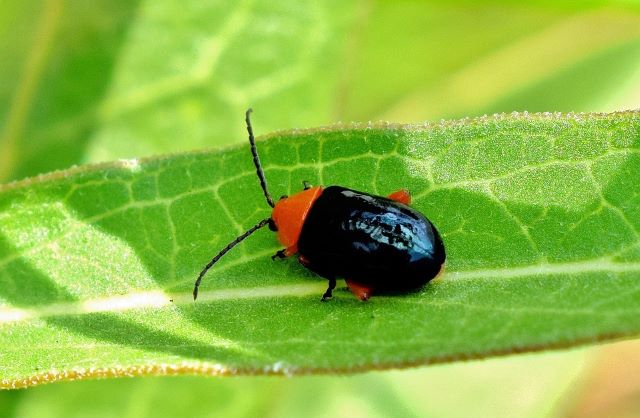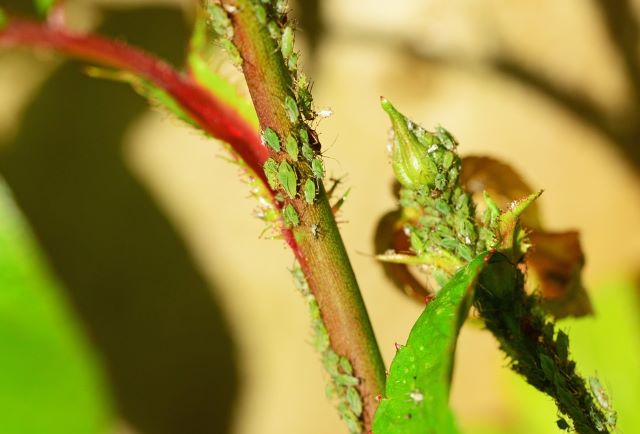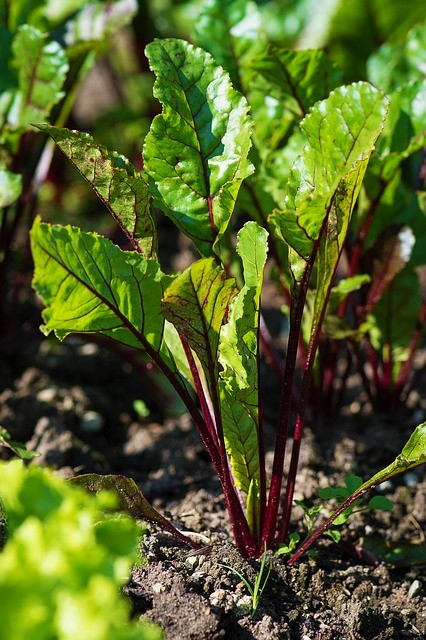Beets are a dream for gardeners of many stripes, often proving easy to grow, compact, delicious, and nutritious. However, growing beets isn’t always a smooth process. If you think your beets are dying or wilting, you’ll want to get to the bottom of what’s causing it.

Although beets are generally quite resilient, they can be affected by certain pests, diseases, poor soil conditions, and high temperatures. In extreme cases, any of these factors can cause beets to die prematurely.
Fortunately, there steps gardeners can take to minimize the chance of your beets dying before their time. In this article, we’ll take a closer look at some of the most common factors damaging beets, as well as ways you can try to keep your beets healthy and happy until the harvest comes.
Table of Contents
Garden Pests Affecting Beets
Humans aren’t the only ones partial to a tasty beet. There are, unfortunately, a number of small critters also looking to dine on the leaves of this nutritious crop.
Although moderate amounts of pest damage won’t necessarily spell disaster for your beet plant, too much can cause irreparable harm or even death. Any damage to beet leaves will also reduce the plant’s capacity to photosynthesize, which in turn limits the energy it can expend on growth.
As we shall soon see, certain pests can also spread diseases that may prove fatal to beets. Other critters are just voracious eaters. Here are some of the most common visitors to beet crops, as well as a few methods for keeping them at bay.
Flea Beetles

These small insects can come in black, dark brown, or dark blue, and are usually shiny. Adults can be 1/8 – 5/32 inches (3 to 4 mm) long, with oversized back legs. They usually jump out of sight when disturbed, hence the name.
Flea beetles will often leave numerous small, irregularly spaced holes in beet leaves. Mature beet plants can often cope with this, but it can spell the end of beet seedlings that are just starting out.
Some method for reducing the risk to beet crops is by growing beet seedlings under insect-proof mesh. You can also consider delaying transplanting your beet seedlings outdoors until they are big enough to handle a bit of insect nibbling.
Keeping your garden beds clear of leaf litter and weeds is also important. Flea beetles, along with other troublesome insects, will often use garden litter as overwinter cover.
Finally, encouraging frogs, birds, and ground beetles to share your garden can keep flea beetle populations in check.
Aphids

You’ll see plenty of edible crops on an aphid menu. Beets are unfortunately no exception. These tiny insects will sap the nutritious juices from the beet plant and will also leave behind a sweet, sticky secretion known as honeydew.
Honeydew, in turn, can encourage the growth of black mold.
Aphids are also spreaders of the fatal mosaic virus, which we will soon be discussing in more detail. Keeping them off your beets is therefore important for a whole host of reasons.
Removing smaller aphid infestations by hand or with mild soap and water can be enough to prevent larger numbers from amassing. However, it’s also a good idea to take preventative steps.
Planting trap crops such as nasturtiums, nettles, or asters elsewhere in the garden can attract aphids away from your edibles. You can also consider planting aphid-repellent crops such as dill, marigolds, or catnip in between your beets and your trap bed.
Healthy ecosystems are also important for keeping aphid numbers down. Ladybirds are one of the most effective natural predators of aphids. Make your garden attractive to ladybirds and other aphid-eaters by planting cilantro, geraniums, or cosmos.
Finally, you can also use horticultural neem oil to keep aphids off your beet plants.
Leafhoppers
As the name suggests, these small, pale green, wedge-shaped bugs tend to leap or fly from plant to plant, munching as they go. Tomato and potato foliage are also leafhopper favorites, but beet leaves can often prove irresistible.
Leafhoppers are predominantly an issue in the western United States and western regions of Canada. They are also found throughout Mexico and parts of Central America.
Floating row covers can be a good way of preventing leafhoppers from latching on to your crop during their dining tour of your backyard.
Ladybugs, lacewings, and minute pirate bugs are all commercially available predators of the leafhopper.
Keeping leafhoppers off your beets is also important because they are the only known carriers of curly top disease, a virus that can affect beets and other edible crops. Read on for more information about curly tops and how to spot the signs.
Diseases Affecting Beets
There is a range of diseases, many of which are fungal, that can adversely affect beet plants. In many instances, these diseases can prove fatal for the beetroot crop. Fortunately, there are things you can do to minimize the chance of your beet plants becoming infected.
Root Rot
This is a fungal infection that primarily targets the beet plant’s subsoil areas. Below the surface, the roots of your beets may start to develop dark brown or black areas of fungal growth.
Above ground, the first thing you may notice is beet plants wilting and then failing to recover when watered. You may also be perplexed by the fact that your beets look a little healthier at night.
Eventually, yellowing between leaf veins can set in. Your beets by this stage are likely struggling to absorb the nutrients they require, due to damage to the root system.
Overwatering your beets is often a primary factor in the development of root rot. Ensuring that your beets are planted in well-draining soil is crucial. Avoid watering to the extent that the crop is left in saturated soil for long periods of time.
Unfortunately, once the disease does set in, it can’t be reversed. The only real option is to pull your beets before disposing of the crop by incinerating or putting them in the general rubbish. Make sure you don’t compost them, as this could spread the fungus to other parts of the garden.
When planting new beets, avoid putting them in the same spot affected by root rot for at least 5 years, as the fungus can lie dormant in the soil for significant periods of time.
Damping Off
Fungi cause Damping off. It often affects beet seedlings and young plants more than it does establish beets.
You may notice wet, brown, squishy stems on your beet seedlings. If you pull them up, you might notice that the roots have turned black. Occasionally, a fuzzy white mold may coat the surface of the earth around the affected plants.
In order to avoid this lethal disease, make sure you use properly treated beet seed stock from reputable seed suppliers. Practicing annual crop rotation can also help discourage the fungus from establishing a foothold in the crop.
Adequate spacing in your garden will also help to ensure your beets have good air circulation. A good rule of thumb is to ensure each beet plant has at least 4 inches (10 cm) of space, in rows that are roughly 18 inches (46 cm) apart.
Mosaic Virus
This virus causes small, light-colored flecks to appear on young beet leaves. Later on, you may notice the green in between the veins of leaves turning pale and yellow before necrosis starts to set in. The virus can also cause stunting of the roots.
Unfortunately, if a plant contracts the disease you will need to pull your beet crop and burn it, as there is no cure or way to reverse the damage.
The good news, however, is that the virus is spread by aphids rather than wholly invisible routes. This means if you can prevent aphids from amassing on your beets you can avoid the plant becoming infected in the first place. Just follow our tips on keeping aphids off your beets to keep your beets safe.
Curly Top Disease
The main features of this viral disease are beet leaves rolling inward, becoming small and discolored, and developing purple edges. You may also notice veins towards the bottom of beet leaves becoming swollen, with the stems turning stiff.
Your beets’ root systems may also start to twist in upon themselves, becoming incapable of soaking up nutrients required by the plant.
The virus is frequently spread by leafhoppers. Follow our previous tips on keeping your beets free from these jumping pests. It’s also worth choosing disease-resistant beet varieties to plant.
Downy Mildew
This mold disease can be fatal to beets. Appearing as gray mold on the beet leaves, as well as light green spots. The disease can also move to the crown of the beet and cause bulbs to be mishappen.
An organic biofungicide can be used but if it is not successful, the beet plant should be removed and destroyed to prevent spread.
Preventative measures include giving beets adequate spacing and avoiding overwatering.
Poor Soil Conditions Can Cause Beets to Wilt or Die

If your beet plants are not struggling because of pests or disease, it may be that the soil conditions are not quite right for them.
Generally speaking, beets are relatively forgiving plants that can survive and even thrive without needing too much love and attention. However, like most edible crops, they do require well-draining, nutrient-rich soil in order to do well.
Beets grow best when the soil pH is between 6.5 and 7. You can test your soil with a soil pH monitor.
Dig plenty of well-aged manure and compost into the garden before planting your beets. A well-balanced, slow-release, organic fertilizer is also beneficial to help give beets a boost, particularly if you think the soil is deficient.
Watering shouldn’t be a problem with beets unless you overdo it. Beets can develop deep roots, which allows them to draw moisture from regions of the soil that other, shallow-rooted plants simply can’t reach. Unless the weather is particularly dry and hot, they are unlikely to require watering more than once or twice a week.
Temperatures Are Too High For Beets

As a cool season crop, beets do best in cooler temperatures. The ideal temperature to grow beets is around 50-70°F (10-21°C). If temperatures rise too far above 75°F (24°C), then beets will suffer and in really hot weather, may even die.
Most likely though, a rising temperature will send the beet plant through its lifecycle prematurely. This may result in early flowering (bolting) and smaller beets.
If you expect warmer weather, consider shading your beet plants from the hottest part of the day. You can use shade cloth, or some dedicated gardeners set up a temporary umbrella to shade out the sun and help keep cool weather beets from getting too hot.
Mulching around the beet plants also helps and will keep the soil cooler and maintain soil moisture.
Related Reading:
